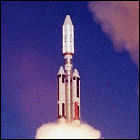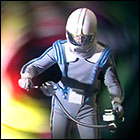Titan IIIe
 In advance of the Viking and Voyager interplanetary missions, which will need more powerful boosters to heft heavier spacecraft into deep space, NASA conducts a test launch of the Titan IIIe/Centaur launch stack, an experimental combination of the venerable Titan rocket and a liquid-fueled Centaur upper stage. Previous Centaur upper stages were attached to wider Atlas rockets, so the unusual bulb-shaped payload shroud of the Centaur is of concern when placed atop the Titan, which has a more narrow diameter; if successful, however, this configuration could launch payloads three times larger than an Atlas/Centaur combination. The test flight, originally scheduled for January 24th, actually fails – a loose part causes the Centaur stage to fizzle rather than fire – and the rocket is destroyed in mid-air. However, with worries about the large Centaur payload atop the narrow Titan rocket laid to rest, NASA approves the Titan IIIe/Centaur for flight, beginning with the launch of a joint American/German science satellite, HELIOS-1, later in 1974.
In advance of the Viking and Voyager interplanetary missions, which will need more powerful boosters to heft heavier spacecraft into deep space, NASA conducts a test launch of the Titan IIIe/Centaur launch stack, an experimental combination of the venerable Titan rocket and a liquid-fueled Centaur upper stage. Previous Centaur upper stages were attached to wider Atlas rockets, so the unusual bulb-shaped payload shroud of the Centaur is of concern when placed atop the Titan, which has a more narrow diameter; if successful, however, this configuration could launch payloads three times larger than an Atlas/Centaur combination. The test flight, originally scheduled for January 24th, actually fails – a loose part causes the Centaur stage to fizzle rather than fire – and the rocket is destroyed in mid-air. However, with worries about the large Centaur payload atop the narrow Titan rocket laid to rest, NASA approves the Titan IIIe/Centaur for flight, beginning with the launch of a joint American/German science satellite, HELIOS-1, later in 1974.
 The
The